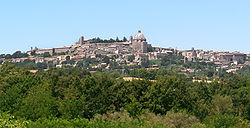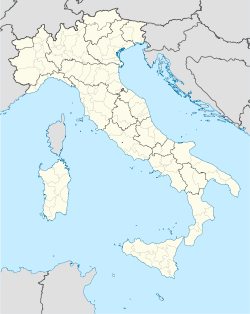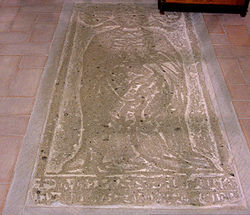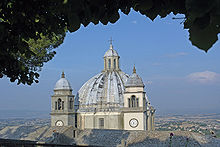- Montefiascone
-
Montefiascone — Comune — Comune di Montefiascone 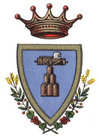
Coat of armsLocation of Montefiascone in Italy Coordinates: 42°32′25″N 12°02′13″E / 42.54028°N 12.03694°E Country Italy Region Lazio Province Viterbo (VT) Frazioni Le Coste, Le Grazie, Le Mosse, Zepponami Government - Mayor Luciano Cimarello (since May 2011) Area - Total 104 km2 (40.2 sq mi) Elevation 590 m (1,936 ft) Population (2008) - Total 13,486 - Density 129.7/km2 (335.9/sq mi) Demonym Montefiasconesi or Falisci Time zone CET (UTC+1) - Summer (DST) CEST (UTC+2) Postal code 01027 Dialing code 0761 Patron saint St. Margaret of Antioch Saint day July 20 Website Official website Montefiascone is a town and comune of the province of Viterbo, Italy, located on a hill on the southeast side of Lake Bolsena, 95 km north of GRA (Rome).
Contents
History
The name of the city derives from that of the Falisci (Mons Faliscorum, "Mountain of the Falisci"). Later, it was controlled by the Etruscans. It was suggested that Montefiascone occupies the site of the Etruscan Temple called Fanum Voltumnae, at which the representatives of the twelve chief cities of Etruria met in the days of their independence. Under the Empire, the festival was held near Volsinii.
The first documents mentioning Montefiascone are from 853 CE, when it belonged to the bishop of Tuscania. In 1058 and 1074 the Popes Stephen IX and Gregory VII, respectively, stopped here. In 1093 the fortress was besieged by Emperor Henry IV. The importance of the fortress was confirmed by Emperor Frederick Barbarossa's visit in 1185.
In the following two centuries, as a Papal possession, Montefiascone lived its period of highest splendour. The Castle was often residence of Popes, and was consequently enlarged and embellished. During Avignon Papacy, it was the main residence of the Papal legate Cardinal Albornoz. In 1463, however, it was already decaying, as in the words of by Pope Pius II. The decline increased after the plague of 1657 and the earthquake of 1697.
It became part of the new Kingdom of Italy in 1870. It was damaged by two Allied bombings in May 1944.
Main sights
- Montefiascone Cathedral is one of the earliest structures by Michele Sanmicheli. Dedicated to Saint Margaret (Santa Margherita), the cathedral was a ruin in 1330 and took three centuries to rebuild. Subsequently, in 1670, it suffered a serious fire, with repairs taking a further decade. The interior was elaborately restored in 1893.[1]
- The church of Santa Maria delle Grazie, also by Sanmicheli.
- The church of San Flaviano (built in 1032, repaired and enlarged in the Gothic style late in the 14th century), a curious double church of importance in the history of architecture; in its interior some 14th-century frescoes were discovered in 1896. In the crypt is the grave of a traveler who succumbed to excessive drinking of the local wine known as Est! Est!! Est!!!. The story is that his valet, who preceded him, wrote "est" on the doors of all the inns where good wine was to be had, and that here the inscription was thrice repeated.
- Rocca dei Papi is the remains of the old Papal summer residence. At the top of the hill it provides a tremendous view of Lago Bolsena.
- The town piazza is the place to see and be seen on a warm summer evening.
- Church of Santa Maria di Montedoro
- Falesco winery is located there.
References
 This article incorporates text from a publication now in the public domain: Chisholm, Hugh, ed (1911). Encyclopædia Britannica (11th ed.). Cambridge University Press.
This article incorporates text from a publication now in the public domain: Chisholm, Hugh, ed (1911). Encyclopædia Britannica (11th ed.). Cambridge University Press.- ^ Wayland Kennet and Elizabeth Young, 1990, "Northern Lazio - an Unknown Italy" John Murray, London.
External links
Lazio · Comuni of the Province of Viterbo Acquapendente · Arlena di Castro · Bagnoregio · Barbarano Romano · Bassano Romano · Bassano in Teverina · Blera · Bolsena · Bomarzo · Calcata · Canepina · Canino · Capodimonte · Capranica · Caprarola · Carbognano · Castel Sant'Elia · Castiglione in Teverina · Celleno · Cellere · Civita Castellana · Civitella d'Agliano · Corchiano · Fabrica di Roma · Faleria · Farnese · Gallese · Gradoli · Graffignano · Grotte di Castro · Ischia di Castro · Latera · Lubriano · Marta · Montalto di Castro · Monte Romano · Montefiascone · Monterosi · Nepi · Onano · Oriolo Romano · Orte · Piansano · Proceno · Ronciglione · San Lorenzo Nuovo · Soriano nel Cimino · Sutri · Tarquinia · Tessennano · Tuscania · Valentano · Vallerano · Vasanello · Vejano · Vetralla · Vignanello · Villa San Giovanni in Tuscia · Viterbo · Vitorchiano
Wikimedia Foundation. 2010.

